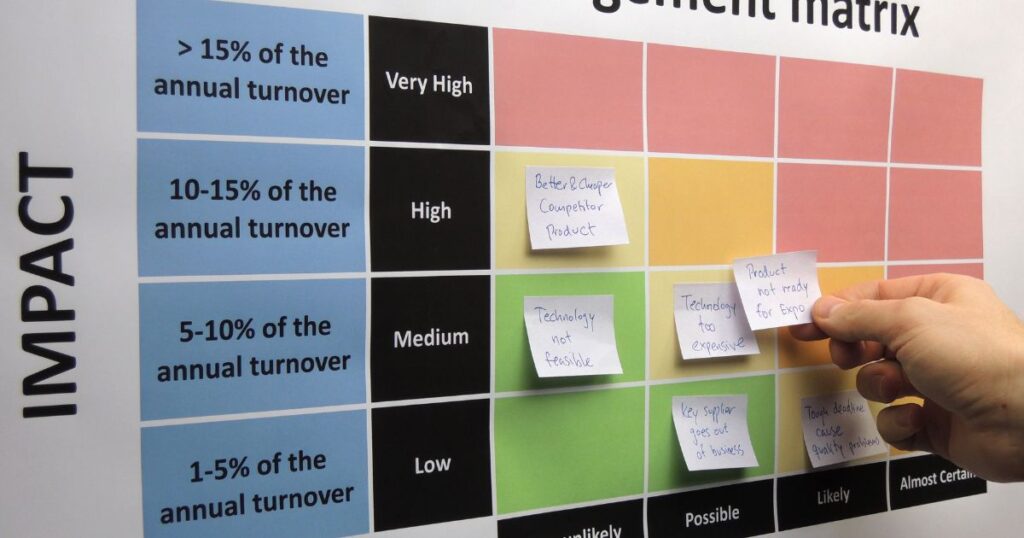In today’s dynamic business environment, effective project support is crucial for achieving successful outcomes. A fundamental aspect of this support is project risk management, which involves identifying, assessing, and mitigating potential risks that could impede project success. Without a structured approach to risk management, projects may face delays, budget overruns, and compromised quality. Implementing risk mitigation strategies and conducting thorough project risk assessments are essential practices to navigate these challenges. By adopting risk management best practices, organisations can proactively address uncertainties, ensuring that projects are completed on time, within budget, and to the desired quality standards.
At 29FORWARD Australia, we specialise in providing comprehensive project support services, including robust risk management frameworks, to help businesses streamline operations and achieve their project goals.

1. Understanding Project Risk Management
Project risk management is the systematic process of identifying, analysing, and responding to potential risks that could impact a project’s objectives. This discipline ensures that uncertainties are managed proactively, minimising adverse effects on project scope, schedule, cost, and quality. (Project Manager)
Common types of project risks include:
- Operational Risks: Arise from inadequate or failed internal processes, people, or systems affecting project operations.
- Strategic Risks: Stem from adverse business decisions or the failure to implement appropriate business strategies, impacting project alignment with organisational goals.
- Cost Risks: Occur when project costs exceed initial estimates, leading to budget overruns.
Market Risks: Involve changes in market conditions that can affect project success, such as shifts in demand or increased competition.
Recognising and understanding these risk categories is crucial for implementing effective risk management process steps. By doing so, organisations can better navigate uncertainties and enhance the likelihood of project success.

2. Early Risk Identification is Key
Early project risk identification is crucial in the project lifecycle, as it enables proactive management of potential issues that could hinder success. By recognising risks at the outset, teams can develop strategies to mitigate their impact, ensuring smoother project execution.
Common tools and techniques for identifying risks include:
- Brainstorming: Gathering team members to generate a comprehensive list of potential risks through open discussion. (Project Risk)
- Stakeholder Interviews: Engaging with stakeholders to gain insights into possible risks from their perspectives.
- Nominal Group Technique (NGT): A structured method where participants independently write down ideas, which are then shared and discussed collectively. (Risk Identification)
- Affinity Diagrams: Organising ideas into categories based on their natural relationships, helping to identify related risks.
- SWOT Analysis: Evaluating the project’s strengths, weaknesses, opportunities, and threats to uncover potential risks.
Involving cross-functional teams in the risk identification process is vital, as it brings diverse perspectives and expertise, leading to a more thorough understanding of potential risks. This collaborative approach ensures that risks are not overlooked and that the team is better prepared to address challenges as they arise.

3. Risk Assessment: Prioritising What Matters
Conducting a thorough project risk assessment is essential for prioritising potential threats based on their likelihood and impact. This process enables project managers to allocate resources effectively and develop appropriate risk response plans.
Qualitative vs. Quantitative Risk Analysis
Risk assessment typically involves two primary approaches: qualitative and quantitative analysis.
- Qualitative Risk Analysis: This method evaluates risks based on subjective criteria, such as expert judgment, to determine their severity and probability. Tools like risk matrices are commonly used to categorise risks into levels (e.g., low, medium, high) based on their potential impact and likelihood. This approach provides a quick and cost-effective means to prioritise risks, especially when numerical data is limited.
Quantitative Risk Analysis: In contrast, this approach employs numerical data and statistical techniques to measure risk impact and probability. Methods such as Monte Carlo simulations and sensitivity analysis are utilised to predict the potential effects of risks on project objectives, offering a more detailed risk evaluation.
Risk Scoring and Prioritisation
To systematically prioritise risks, organisations often implement risk scoring methods. This involves assigning numerical values to the likelihood and impact of each risk, and then calculating a risk score by multiplying these values. For example, a risk with a high probability (rated 4) and significant impact (rated 5) would have a risk score of 20. This quantitative measure aids in identifying which risks require immediate attention and resource allocation.
By integrating these risk analysis techniques, project managers can develop a comprehensive understanding of potential challenges, facilitating informed decision-making and enhancing the overall resilience of the project.
Intelligent Test Data Management
AI automates the generation of test data while ensuring compliance with privacy regulations such as GDPR and CCPA. This approach allows businesses to create secure and realistic test environments efficiently.
Example: IBM’s DataOps platform employs AI to streamline data management processes, enhancing data quality and compliance for large enterprises

4. Building Strong Mitigation Strategies
Developing robust risk mitigation strategies is essential for reducing the impact of potential threats on project outcomes. These strategies involve proactive measures to address identified risks before they materialise, thereby safeguarding project objectives.
Common Risk Mitigation Strategies
- Risk Avoidance: This approach involves altering project plans to circumvent potential risks entirely. For instance, if a particular activity is deemed too risky, it may be excluded from the project scope. ProjectManager
- Risk Reduction (Control): This strategy focuses on implementing actions to minimise the likelihood or impact of a risk. Examples include adopting new technologies to enhance efficiency or providing additional training to team members to prevent skill-related issues. Job Search | Indeed
- Risk Transference: In this approach, the risk is shifted to a third party, often through contractual agreements or insurance policies. For example, outsourcing certain project components can transfer specific risks to external vendors. ProjectManager
Risk Acceptance: This strategy entails acknowledging the risk without taking immediate action, typically because the potential impact is deemed manageable or the cost of mitigation outweighs the benefits. Project Manager
Proactive Mitigation Techniques
- Contingency Planning: Developing predefined action plans to address potential risks ensures that the project team can respond swiftly and effectively when issues arise.
- Resource Buffers: Allocating additional time, budget, or personnel as a buffer can help absorb the impact of unforeseen challenges, maintaining project stability.
Integrating these risk mitigation strategies into the project management process enhances the project’s resilience, ensuring that potential threats are managed effectively and project objectives are achieved.

5. Best Practices for Managing Risk
Implementing risk management best practices is crucial for ensuring project success. Key practices include:
- Assign a Risk Manager: Designate a dedicated individual to oversee risk management activities, ensuring that potential issues are promptly identified and addressed. MPUG
- Continuous Risk Monitoring: Regularly track identified risks and remain vigilant for new ones throughout the project lifecycle. This ongoing process allows for timely adjustments to risk response plans.
- Clear Communication: Maintain transparent communication channels among all stakeholders to ensure that everyone is informed about potential risks and mitigation strategies. MPUG
- Establish Clear Policies and Procedures: Develop and document comprehensive risk management policies to provide a structured approach for identifying, assessing, and mitigating risks.
- Promote a Risk-Aware Culture: Encourage an organisational culture that recognises the importance of risk management, ensuring that team members are proactive in identifying and reporting potential issues.
By integrating these best practices into your project management approach, you can enhance your team’s ability to anticipate, assess, and address potential risks, thereby increasing the likelihood of project success.

Frequently Asked Questions (FAQs)
Project risk management involves a series of structured steps to identify, assess, and mitigate potential risks that could impact a project’s success. The key steps include:
- Risk Identification: Systematically pinpointing potential risks that could affect the project.
- Risk Analysis: Evaluating the identified risks to understand their potential impact and likelihood.
- Risk Prioritisation: Ranking risks based on their severity and probability to focus on the most critical ones.
- Risk Response Planning: Developing strategies to address identified risks, such as mitigation, avoidance, transfer, or acceptance.
- Risk Monitoring and Control: Continuously tracking identified risks and identifying new ones throughout the project lifecycle.
Implementing these steps ensures a proactive approach to managing uncertainties in projects.
The four primary risk mitigation strategies are:
- Risk Avoidance: Altering project plans to eliminate potential risks entirely.
- Risk Reduction: Implementing measures to decrease the likelihood or impact of a risk.
- Risk Transfer: Shifting the risk to a third party, such as through insurance or outsourcing.
- Risk Acceptance: Acknowledging the risk without immediate action, typically when the risk’s impact is minimal or mitigation costs exceed potential losses.
These strategies provide a framework for effectively managing risks in project management.
Risk management is vital in project management because it:
- Enhances Decision-Making: Provides a structured approach to identifying and assessing risks, leading to informed decisions.
- Improves Project Outcomes: Proactively addressing potential issues increases the likelihood of meeting project objectives.
- Optimises Resource Allocation: Prioritising risks ensures that resources are focused on the most critical areas.
- Increases Stakeholder Confidence: Demonstrates a commitment to identifying and managing uncertainties, building trust among stakeholders.
Effective risk management contributes to the overall success and sustainability of projects.

Conclusion: Building Resilience Through Effective Project Risk Management
Minimising risk is not just about avoiding problems—it’s about enabling projects to succeed under pressure. By implementing structured project risk management processes, from early risk identification to ongoing monitoring and control, organisations can enhance agility, protect resources, and deliver results with greater confidence.
At 29FORWARD Australia, we support businesses in building tailored risk frameworks that align with their goals and drive better project outcomes.
📩 Ready to strengthen your project resilience? Get in touch with us to explore how our expert-led project support services can help you manage risks effectively and deliver projects with confidence.
